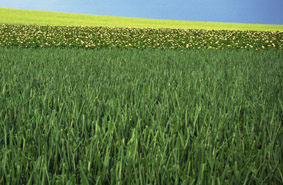
To facilitate the government with its decision-making regarding grain yields, Chen Xikang and colleagues of the CAS Academy of Mathematics and System Sciences completed in late April their 2003 prediction on the yields of grain, cotton and oil crops.
Feeding 1.3 billion people is, and for the foreseeable future will be, China's top priority. To facilitate the government with its decision-making in terms of grain production, a research team headed by Chen Xikang of the CAS Academy of Mathematics and System Sciences completed in late April its 2003 prediction on the yields of grain, cotton and oil crops. This is the 24th year in succession for them to carry out such a task. All previous work has been successful, winning accolades from top government officials.
Three approaches are commonly adopted to forecast grain yield and output in the world, namely, meteoric, remote-sensing, and biological statistical simulation methods. However, these techniques generally look no more than two month in advance and have an error rate somewhere between 5 to 10 percent.
To alleviate the problem, Chen and colleagues developed a systematic integrated approach, which takes into account the influences of agricultural inputs, technological advancements, natural factors such as climate and pests, and policies on grain output. The novel method involved key techniques of input-occupancy-output analysis (an extension of classical input-output analysis), variable coefficient forecasting equation with the consideration of the diminishing return law for fertilizers, and the minimum sum of absolute value treatment.
This approach has been successfully implemented in China since 1980. CAS submits to the Chinese government its annual report on grain output prediction in each May. The forward time of prediction is over half a year, and the average error rate of prediction is only 1.9 percent, with the right forecasting direction of bumper, normal or poor harvest.
The achievement received a first prize of CAS Award for Science & Technology Advancement in 1992, a third prize from the State Award for Science & Technology Advancement in 1996, and a first prize for development from the International Federation of Operational Research Societies in 1999.





